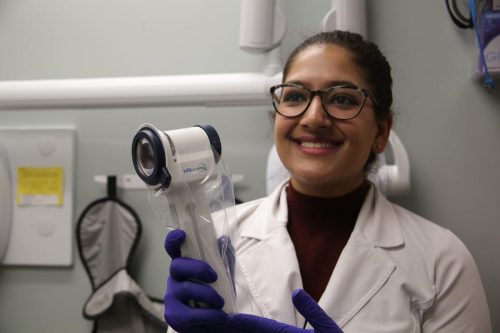Source: www.newsbug.info
Author: Bob Moulesong
According to the Oral Cancer Foundation, almost 50,000 cases of oral cancer will be diagnosed in the U.S. in 2018. The American Cancer Society reports that 10,000 people will die from the disease this year. Half of all people diagnosed with oral cancer will be alive in five years, according to both sources.
While those are disquieting statistics, Region physicians say routine checkups and early diagnosis improve the odds.
Oral cancer
Oral cancer includes cancers of the lips, tongue, cheeks, floor of the mouth, hard and soft palate, sinuses, saliva glands, and throat.
“People we see usually come to us for a lesion or ulcer found in the mouth or throat,” says Dr. Akta Kakodkar, an ear, nose and throat specialist with Community Healthcare System. “Some of them experience no pain but notice a growth or patch of discolored tissue in their mouth, cheek or gum.”
Kakodkar, who with her husband and fellow Community ENT physician, Dr. Kedar Kakodkar, treats oral cancer patients, is quick to point out that not every lesion, ulcer or mouth sore is cancer.
“We see hundreds of nervous patients who have bacterial or fungal infections,” she says. “Treatment with antibiotics or antifungal medications clear up many of these lesions. There are also many white and red patches that clear up on their own.”
The only way to know is a thorough examination.
Types and risk factors
“Most cases of oral cancer are linked to use of tobacco, alcohol and betel nuts, or infection with HPV,” Kakodkar says. “There are major risks associated with tobacco use, whether it’s smoking or chewing.”
There are two main types of oral cancer. Most prevalent is squamous cell carcinoma, accounting for more than 90 percent of cancers that occur in the oral cavity and oropharynx. Slow-growing verrucous carcinoma makes up more than 5 percent of oral cavity tumors.
First steps
Kakodkar says prevention is the best defense. “Your primary care physician may examine your head, neck, mouth and throat for abnormalities,” she says.
Self-exam may uncover a lesion or sore. “Remember, many of these are very treatable and are not cancer,” Kakodkar says. “But don’t wait. Cancer never goes away by itself.”
When Kakodkar discovers a suspicious lesion, she recommends a biopsy: “Depending on several variables, we might do the biopsy in clinic, or we may do it in a hospital setting.”
Once the results return, a plan of action can be established. “Usually, the next steps include imaging, such as a CT scan,” she says. “We also order a PET scan, which tells us what stage the cancer is in and whether or not it has spread.”
Treatment
Kakodkar says she prefers to go straight to surgery. “Many oral cancers are still small and local,” she explains. “Removing them completely is the best way to stop the spread of the cancer.”
Depending on the type and stage of the cancer, radiation and/or chemotherapy may be used.
“I want people to know that surgery for oral cancer is frequently a simple procedure,” Kakodkar says. “Oral cancer is frequently found early due to its visibility. Almost 90 percent of cancer patients in stage 1 or 2 recover and survive.”
A dental checkup
“Oral cancer screening is crucial during a dental examination,” says Dr. Ami Pandya, dentist at Family Dental Care in Valparaiso. “Recognizing abnormal tissue in a patient’s mouth could indicate precancerous tissues, and when identified early could save your life.”
A dentist will perform a thorough head and neck exam, which includes an oral cancer screening. “Dentists will complete extraoral examinations by palpating your jaw line to feel for any suspicious lumps that are not routinely present in these areas,” Pandya says.
A dentist will examine the intraoral tissues of your mouth and look for any suspicious lesions. “We examine the patient’s tongue, the floor of their mouth, and their gingival tissue,” Pandya says. Red and/or white patches can become cancerous.
Many doctors including Pandya have begun using VELscope, a light-based technology to detect precancerous tissues. It’s a wireless hand-held device that scans tissue, with abnormalities showing up as a dark black color.
“VELscope can detect abnormalities before they have a clinical presentation,” Pandya says. “It’s an incredible aid with oral cancer screening.”
Pandya recommends an annual VELscope examination for low-risk adults. Higher risk patients should get a VELscope exam each appointment.

Under the VELscope, cancer shows up as black, says Dr. Ami Pandya
If the dentist detects an abnormality, he or she informs the patient, noting the size, color and location of the lesion. A two-week follow-up is standard. “Oftentimes, these lesions resolve,” Pandya says. If it doesn’t resolve after two weeks, the patient is referred for further evaluation.
Note: This article originally ran on nwitimes.com.

Leave A Comment
You must be logged in to post a comment.